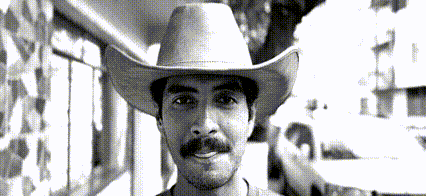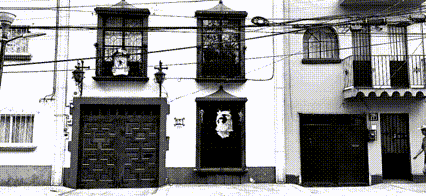In Conversation With Walter Arellano: Interview VII
“IN CONVERSATION WITH” IS A CONVERSATIONAL INTERVIEW SERIES WHERE WE SIT DOWN WITH CONTEMPORARY ARTISTS AND DISCUSS TOPICS THAT ARE IMPORTANT TO THEM.
(All conversations are recorded, and transcribed by BrassTuna.)
This conversation has been edited for length and clarity
“Walter Arellano is a multidisciplinary artist specializing in photography direction and audiovisual production. With over twelve years of experience, he has worked on music videos, video art, creative concepts, and advertising projects. Since childhood, he has been surrounded by various art forms that have shaped his personal and professional growth, allowing him to explore painting, drawing, writing, and graphic design.
When he discovered photography and audiovisual art, he found an avenue to merge all his artistic interests. In addition to developing projects for various clients, Walter has also found solace in telling his own stories, where themes of fantasy, childhood, and the connection to the body come to life.”
BrassTuna: Hello Walter, thank you so much for having me here today.
Would you mind starting off by telling our readers a bit about yourself?
W.A: I’m Walter Arellano; I am thirty-two years old and am living in Mexico City.
I work in video production and am a cinematographer.
I also have many hobbies that involve the arts. I like to paint, to dance ,,, in my free time I like to move my body and have a connection with the music.
I think one of my best relationships is between my body and the music ,,, and I try to always do art.
BrassTuna: Can you tell me about your video/photo style?
How did you develop that specific style in your work?
W.A: “First, I try to have a connection to the people I am shooting.
Like ,,, I try to make people feel like I don’t have a camera.
You know, making a comfortable feeling. It’s kind of like a dance. I try to do this choreography with the camera and the people. Maybe they have experience as an actor, or maybe not, so I kind of try to form this connection to the person that I have in front of the camera.
For example, in the studio, I try to make the space comfortable. I think that in different productions, things like the lighting can make them uncomfortable.
I like to play with the colors and the textures in the space.
It depends on the project ,,, you can be so careful with lighting because the clients have very specific projects.
But sometimes you can play like a child, and can get an idea, but it’s cool if the idea changes and the color is different. I try to make the person comfortable with me, and I know that I may have a talent with the camera. *haha*”
BrassTuna: What moment from your childhood do you think played a role in your artistic adventure as an adult? Or at what moment do you think you became an artist?
W.A: “Maybe when I would play with my toys as a kid. When I was a kid, I had amazing toys *haha*
Back then, there were Pokemon, Digimon, transformers ,,, so many series. I remember I had all the toys of the characters ,,, like Digimon, that would transform into other characters and evolutions. I think in those moments, I started making up stories with them. All day.
In my room or in the garden, I would play like “This is a bad character, and this is good,” and would take them on adventures.
I don't remember the exact moment I started drawing or painting, but when I would paint and draw, I would try to include those same stories, just on paper or with paint.
And I would be such an intense child, like all the time would need to move around.”
BrassTuna: And you still are *haha*
W.A: *haha*
“Just a bit more calm,
But my mom would say I had so much energy ,,, so first she put me in sports, and I would always think, “Why do people fight over a ball?” *haha*
Like why would they argue? ,,, no, I don’t like that.
Then she put me in different classes, some in the summer. I don’t know what it's called. Is it summer vacation? Where you go to take classes.
I remember when I was growing up in Querétaro ,,, Querétaro would have different “art houses.” The art classes were free, so I loved that you could take art classes all day. You could paint, dance, do theatre, and when I would go to these summer classes, I would start to feel so comfortable.
Because, maybe in school you would feel awkward because other people would like sports but not me.
It was the first time that I felt like if I made a mistake, it was ok. It was part of the learning.
For example, if I would paint “badly” I could fix it. I felt like I had found my place.
When I started to grow up, I remember when I would act in the theatre summer classes, I would say, “This is for me.”
When I grew up, I found the cinema and was like, “Wow, this is the best.”
I felt like I could do other things in art, like record a dancer, or actors, or musicians. I think in those moments, I connected a lot with it.
I think when I started to take those classes in the summer, I would say that I wanted that in my life, and I wanted to stay there.”
BrassTuna: Before we wrap up, what is your biggest goal for yourself this year? It can be a personal goal or one for your art.
W.A: “I have two.
One is traveling around Mexico. I want to make more connections, kind of like me with you and you with me. And that’s so exciting.
Because I think it's so important in my process now. I feel like this year is a little scary because there are so many important things going on.
I think the other is to call myself an artist.
Because I think when I hear someone call me that, I feel ,,,
For example, I like to take videos and photos, but I also like to paint. And I like to dance, and it's another process or a way to make art.
It’s a way to talk about stories, my stories, or someone else’s story. And this year I want to do my first performance, and it’s a very different process.
When I use a camera on a large production its very fast. And that process is just very different.”
BrassTuna: For my last question, in the context of your art, what message would you share with the world?
W.A: “The first thing I thought ,,, as an artist, be kind to yourself. It’s cool to be a perfectionist; it’s part of the process, I feel. Because it helps us learn more.
But I think as we grow up, we can start to form hate within ourselves. And then we start to form bad relationships with ourselves, bad attitudes, etc.
I think that in those moments, we cross a line. For example, if we make mistakes, we start to cause frustration and anger within ourselves. We then believe that our value is zero and stuff like that.
And I think, of course, part of art is you find your people.
But sometimes, we find competition, and it can feel like it destroys you.
But it's like ,,, come on, other people try to destroy you, and then you also try to destroy yourself.
Try to be kind.
Like for example, I continue to try to be part of the art industry, and you know, I have really good times, but it is hard. I think if we are not kids to ourselves and other people, it will be more difficult.
And another thing is that it’s not bad in the process if you choose “another thing” to survive or feel comfortable. Because it can be hard to make your dreams come true. But you need to support yourself. It’s fine because taking jobs, maybe it’s not the type of job I would want to do.
But it's fine; it’s not forever.
I think it’s cool to also see the value in yourself and to know that you want to discover more for yourself.
That’s what I would say to the world: to be kind to yourself.”
BrassTuna: That wraps up the end of our interview today, Walter. Thank you again, its been a pleasure.
You can find Walter Arellano on their Instagram (@walterarellanoo)
(Stay up to date on future BrassTuna “In Conversation With” interviews by following us on Instagram)



